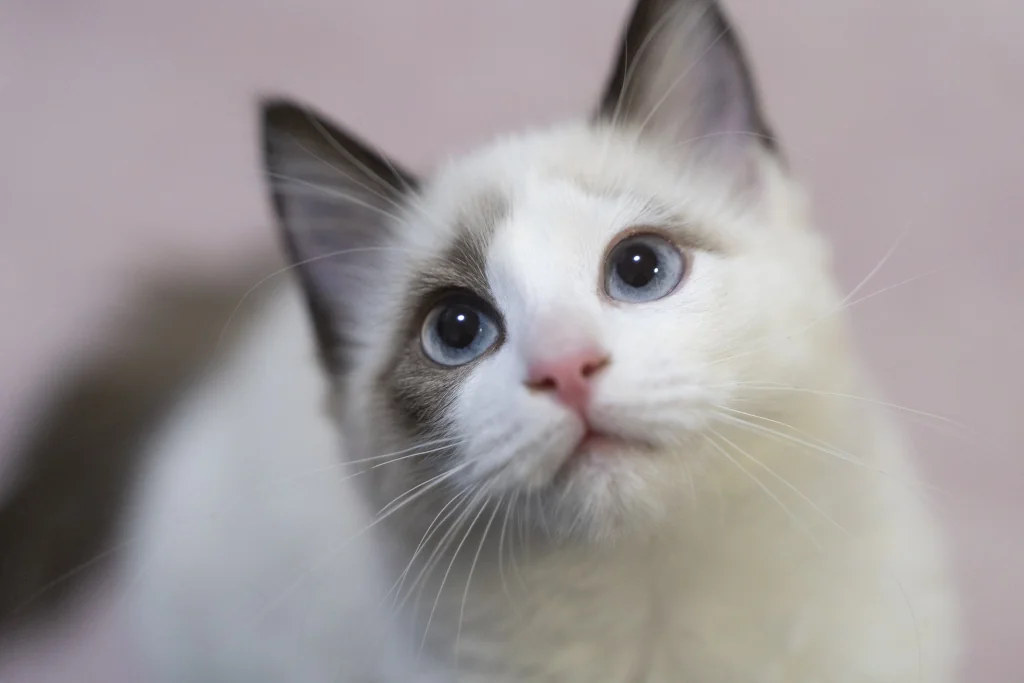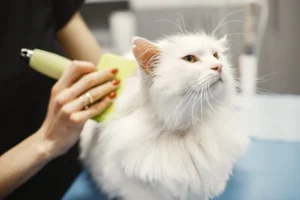Disclosure: We may earn a commission from helpful, relevant links in our content. No cost to you. See our privacy policy.
We all know how cat hair has a way of finding itself in the most unexpected places.
A reality of living with our feline companions is that sometimes, we might find ourselves swallowing some. Now you’re wondering, what happens if you swallow cat hair?
However, that doesn’t mean you should start adding cat hair to your cereal. There’s a lot more to the story with effective ways to reduce cat hair scatter around your home.

Can Swallowing Cat Hair Harm You?
Now let’s address that nagging question: can swallowing cat hair harm you?
Generally, the occasional stray hair won’t pose a significant health risk. In fact, if you’ve been a cat parent for a while, chances are you’ve unknowingly swallowed a cat hair or two with no ill effects.
It’s quite like accidentally swallowing a bit of your own hair. However, large amounts could potentially cause minor digestive issues such as stomach irritation or create hairballs in rare cases.
So, while it’s not a major health concern, you might still want to keep those furballs at bay.
How Does Your Body Process Cat Hair?
You may be wondering what actually happens inside your body when you swallow cat hair.
It’s quite simple really. Much like other indigestible substances, the cat hair you accidentally swallow travels through your digestive system. It is broken down in your stomach as much as possible, and what can’t be digested gets passed along into the intestines.
Eventually, it exits the body naturally through your stools. Think of it as an unplanned guest that your body kindly shows the exit.
Remember, your body is designed to handle small, non-food particles all the time. Cat hair just takes a brief, guided tour before making its exit.
Myths vs. Facts: The Truth About Cat Hair
Let’s demystify some common misconceptions about cat hair:
1. Myth: “Cat hair causes allergies.”
Fact: It’s not actually the cat hair that triggers allergic reactions. Instead, a protein found in cat saliva, urine, and dander (tiny flecks of skin) is the culprit. When cats groom, this protein sticks to their hair and becomes airborne.
2. Myth: “Hairless cat breeds are hypoallergenic.”
Fact: While hairless cat breeds such as the Sphynx might not shed hair around your home, they still produce the protein that can cause allergic reactions. So they’re not completely hypoallergenic.
3. Myth: “Eating cat hair can cause worms.”
4. Myth: “Regular shaving helps reduce cat hair in the house.”
Fact: Shaving your cat isn’t necessarily the solution to shedding. Cat hair helps regulate their body temperature and protects their skin. Regular grooming and proper diet are more effective ways to manage shedding.
Practical Tips to Minimize Cat Hair in Your Home
Now that we’ve separated fact from fiction, let’s explore some practical ways to minimize the presence of cat hair in your home:
- Regular Grooming. Brush your cat frequently to remove loose hairs before they end up on your floor, furniture, or mouth. Choose a high-quality grooming tool designed for your cat’s coat type. A slicker brush or a deshedding tool can work wonders.
- Diet and Hydration. A healthy diet can do more than just keep your cat in good shape – it can also reduce shedding. Good nutrition, along with adequate hydration, supports a healthy coat and less shedding.
- Use Furniture Covers. This might sound like a simple fix, but it’s a game-changer. Using machine-washable furniture covers, especially ones with anti-static properties, can significantly reduce the amount of cat hair you find on your furniture and save you a lot of cleaning time. Simply remove and wash the covers regularly to keep your furniture hair-free.
- Invest in a Good Vacuum Cleaner. Not all vacuum cleaners are created equal when it comes to picking up pet hair. Look for one specifically designed to handle pet hair. Some even have HEPA filters to catch and trap allergens.
- Consider Air Purifiers. Air purifiers can help filter out pet hair and dander from your indoor air. This not only reduces the amount of hair you might swallow inadvertently but also contributes to a healthier home environment overall.
- Try a Lint Roller. A good old lint roller is an underrated tool in battling cat hair. It’s perfect for quick touch-ups on your clothes, furniture, and other surfaces.
- Use a Cat Hair Removal Glove. A hidden gem in the cat hair battle. These gloves have rubber nodules that catch hair, and they can double as a grooming tool, capturing loose hair as you pet your cat. It’s a gentle and enjoyable way to keep your cat’s shedding under control.
Remember, managing cat hair in your home is part of sharing your life with these lovely creatures.
Breathe Easy: A Cleaner, Hair-Free Home Environment
Taking control of the cat hair situation in your home can seem like an uphill battle, but I promise you, it’s achievable and rewarding.
I remember the first time I saw Smokey, my cat, perch on top of my favorite armchair. His striking green eyes met mine, and in that moment, I forgave the flurry of grey hair he left behind. After all, it was his way of marking our shared space.
Over the years, I’ve found that tackling cat hair doesn’t need to be a chore. Instead, it can be incorporated into the routine of nurturing our shared environment.
A combination of regular grooming, cleaning, and smart product choices has allowed me to maintain a hair-free home without overwhelming Smokey or myself.
The result is a cleaner, healthier environment that both Smokey and I can enjoy without concern.
FAQs
Can I develop an allergy to my cat’s hair?
The development of an allergy is more related to a protein called Fel d 1 present in cat saliva and dander, rather than the hair itself. Some individuals may react over time if they’re repeatedly exposed. Follow this guide if you’re allergic, but still want a cat.
What are the most effective tools for removing cat hair from my home?
A vacuum cleaner designed for pet hair, a lint roller for quick clean-ups, and a cat hair removal glove for proactive grooming are among the most effective tools for managing cat hair.
How often should I clean my home to avoid cat hair buildup?
It largely depends on your cat’s shedding patterns and your living environment, but as a general rule, vacuuming twice a week and washing fabric covers regularly can effectively control cat hair buildup.
Are there specific breeds of cats that shed less hair?
Absolutely! Some cat breeds are known for shedding less. These include the Siamese, Russian Blue, and Bengal cats. Remember, less shedding doesn’t mean no grooming is required; every cat needs proper care to maintain a healthy coat.
Alex, a passionate animal lover, has experience in training and understanding animal behavior. As a proud pet parent to two dogs and three cats, he founded AnimalReport.net to share insights from animal experts and expand his knowledge of the animal kingdom.




